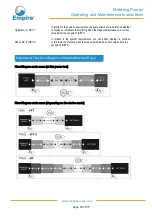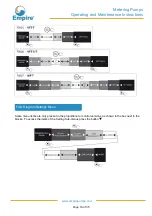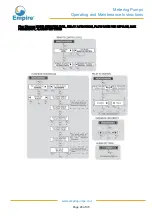
Page 5 of 35
Metering Pumps
Operating and Maintenance Instructions
www.empirepumps.com
The material to be sent to the factory for maintenance should be disassembled and packed carefully; all
the parts in contact with the chemical must be emptied and rinsed to ensure the safety of the operators
while transporting and handling the material in the laboratory. In the event of failure to comply with the
instructions given, we reserve the right to reject the equipment and to return it at your expense; damage
caused by the chemical to the material will be included in the repair estimate.
Assembly and Disassembly
The dosing pumps are usually supplied already assembled. For greater clarity, you can consult the
attachment at the bottom of the manual which illustrates an enlarged view of the pump, and all the
details with its nomenclature, so that you can have a complete picture of the pump components. These
drawings are however indispensable if you have to identify malfunctioning or defective parts. Other
designs, related to the hydraulic parts (pump head and valves) are shown for the same purpose, in the
appendix.
For the eventual dismantling of the pump or before starting work on it:
•
Make sure that it is turned off electrically (both polarities) by disconnecting the connection cables
from the contact points of the network through the opening of a phase switch with a minimum contact
gap of 3 mm (Fig. 6).
•
In an appropriate manner, carefully dispose of any remaining pressure from the pump body and from
the injection tube.
•
Remove all liquid present from the pump body, then proceed by disassembling and reassembling the
pump body, by unscrewing and screwing the four screws (tightening torque: 180 to 200 N * cm).
This last point requires special attention, so please refer to the drawings in Annex 1 and the chapter
"RISKS" before starting any operation.
Operating principle
The operation of the dosing pump is provided by a membrane in PTFE (Teflon ®) mounted on the piston
of an electromagnet. When the piston of the electromagnet is attracted, a pressure is produced in the
pump body with an ejection of liquid from the discharge valve. Once the electric impulse is over a spring
returns the piston to its initial position with a recall of liquid through the suction valve. Given the
simplicity of operation the pump does not need lubrication and requires very little maintenance. The
materials used for the construction of the pump make it suitable for the dosage of chemically aggressive
liquids. The dosing pump is designed for capacities ranging from 1 to 30 l / h and pressures of 4 to 20
bar depending on the model.
Technical Specifications
•
Equipment manufactured in accordance with EC standards.
•
External casing made out of plastic material resistant to acid and temperature.
•
Control panel protected with serigraphic film.
•
Multi voltage power supply 100-250 V 50-60 Hz
•
Degree of protection: IP65






































